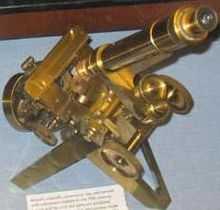Timeline of microscope technology
Timeline of microscope technology

1852 microscope
- c2000 BCE - The Chinese use water microscopes made of a lens and a water-filled tube to visualize the unseen.[1]
- Up to 612 BCE - The Assyrians manufacture the world's oldest surviving lenses.[2]
- 1267 Roger Bacon explains the principles of the lens and proposes the idea of telescope and microscope.[3]
- 1590 - Dutch spectacle-makers Hans Jansen and his son Zacharias Jansen, claimed by later writers (Pierre Borel 1620 - 1671 or 1628 – 1689 and Willem Boreel 1591 – 1668) to have invented a compound microscope.
- 1609 - Galileo Galilei develops a compound microscope with a convex and a concave lens.
- 1612 - Galileo presents occhiolino to Polish king Sigismund III.
- 1619 - Cornelius Drebbel (1572 – 1633) presents, in London, a compound microscope with two convex lenses.
- c.1622 - Drebbel presents his invention in Rome.
- 1624 - Galileo presents his occhiolino to Prince Federico Cesi, founder of the Accademia dei Lincei (in English, The Linceans).
- 1625 - Giovanni Faber of Bamberg (1574 - 1629) of the Linceans coins the word microscope by analogy with telescope.
- 1665 - Robert Hooke publishes Micrographia, a collection of biological micrographs. He coins the word cell for the structures he discovers in cork bark.
- 1674 - Anton van Leeuwenhoek improves on a simple microscope for viewing biological specimens.
- 1863 - Henry Clifton Sorby develops a metallurgical microscope to observe structure of meteorites.
- 1860s - Ernst Abbe discovers the Abbe sine condition, a breakthrough in microscope design, which until then was largely based on trial and error. The company of Carl Zeiss exploited this discovery and becomes the dominant microscope manufacturer of its era.
- 1931 - Ernst Ruska starts to build the first electron microscope. It is a Transmission electron microscope (TEM)
- 1936 - Erwin Wilhelm Müller invents the field emission microscope.
- 1938 - James Hillier builds another TEM
- 1951 - Erwin Wilhelm Müller invents the field ion microscope and is the first to see atoms.
- 1953 - Frits Zernike, professor of theoretical physics, receives the Nobel Prize in Physics for his invention of the phase contrast microscope.
- 1955 - George Nomarski, professor of microscopy, published the theoretical basis of Differential interference contrast microscopy.[4]
- 1967 - Erwin Wilhelm Müller adds time-of-flight spectroscopy to the field ion microscope, making the first atom probe and allowing the chemical identification of each individual atom.
- 1981 - Gerd Binnig and Heinrich Rohrer develop the scanning tunneling microscope (STM).
- 1986 - Gerd Binnig, Quate, and Gerber invent the Atomic force microscope (AFM)
- 1988 - Alfred Cerezo, Terence Godfrey, and George D. W. Smith applied a position-sensitive detector to the atom probe, making it able to resolve atoms in 3-dimensions.
- 1988 - Kingo Itaya invents the Electrochemical scanning tunneling microscope
- 1991 - Kelvin probe force microscope invented.
References
- ↑ Bardell, D. 2004. “The Invention of the Microscope”. Bios. 75 (2): 78-84
- ↑ Bardell, D. 2004. “The Invention of the Microscope”. Bios. 75 (2): 78-84
- ↑ O'Connor, J. J; Robertson, E F. "Roger Bacon".
- ↑ Nomarski, G. (1955). Microinterféromètre différentiel à ondes polarisées. J. Phys. Radium, Paris 16: 9S-11S
.